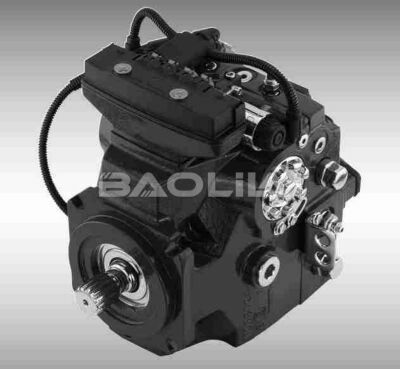Reasons to avoid applying load immediately after starting the hydraulic pump
Avoiding applying a load immediately after starting the hydraulic pump is good practice to ensure smooth and efficient operation of the system. This is often called "no-load starting" or "pump unloading". Here are a few reasons why it is recommended:
1. Reduce wear: Allowing the hydraulic pump to operate without immediate load helps reduce wear on the pump components. Initial startup creates high pressures and stresses, and running the pump without load allows it to gradually stabilize.
2. Avoid cavitation: Rapid application of load can lead to cavitation, a phenomenon in which air bubbles form and burst within the hydraulic fluid due to low pressure. Cavitation can cause damage to pumps and other system components. Starting the pump without immediate load minimizes the risk of cavitation.
3. Gradually build pressure: Allowing the pump to run without immediate load allows the hydraulic pressure to build gradually. This is especially important in systems where sudden pressure spikes may be harmful to the system or its components.
4. Temperature stabilization: No-load starting allows hydraulic oil to circulate and the system temperature to stabilize before it must bear load. This helps prevent overheating and ensures the fluid viscosity is within the desired range.
5. System Protection: No-load starting is good practice to protect the entire hydraulic system, including valves, hoses, and other components, from sudden and potentially damaging pressure surges.
H1-P-060-R-A-A-A3-C1-B-D6-H-G1-H3-L-35-L-35-F-L-24-PN-NNN-NNN H1P060RAAA3C1BD6HG1H3L35L35FL24PNNNNNNN
H1-P-060-R-A-A-A2-C3-N-F5-H-F1-H6-L-35-L-35-F-P-24-PN-NNN-NNN H1P060RAAA2C3NF5HF1H6L35L35FP24PNNNNNNN
H1-P-060-R-A-A-A2-C3-N-D8-H-G1-H2-L-35-L-35-F-P-24-PN-NNN-NNN H1P060RAAA2C3ND8HG1H2L35L35FP24PNNNNNNN
H1-P-060-R-A-A-A2-C3-N-D8-H-F1-NN-L-42-L-42-F-P-22-PN-NNN-NNN H1P060RAAA2C3ND8HF1NNL42L42FP22PNNNNNNN
H1-P-060-R-A-A-A2-C3-B-D8-H-G1-NN-K-40-K-40-N-E-32-PN-NNN-NNN H1P060RAAA2C3BD8HG1NNK40K40NE32PNNNNNNN
H1-P-060-R-A-A-A2-C2-N-F6-H-G1-H6-L-33-L-33-C-L-22-PN-NNN-NNN H1P060RAAA2C2NF6HG1H6L33L33CL22PNNNNNNN
H1-P-060-R-A-A-A2-C2-N-F5-H-F1-H6-L-40-L-40-N-E-22-PN-NNN-NNN H1P060RAAA2C2NF5HF1H6L40L40NE22PNNNNNNN
H1-P-060-R-A-A-A2-C2-N-D8-H-G1-H5-L-40-L-40-N-E-22-PN-NNN-NNN H1P060RAAA2C2ND8HG1H5L40L40NE22PNNNNNNN
H1-P-060-R-A-A-A2-C2-N-D8-H-G1-H2-L-40-L-40-N-E-26-PN-NNN-NNN H1P060RAAA2C2ND8HG1H2L40L40NE26PNNNNNNN
H1-P-060-R-A-A-A2-C2-N-D8-H-F1-H5-L-42-L-42-N-E-26-PN-NNN-NNN H1P060RAAA2C2ND8HF1H5L42L42NE26PNNNNNNN
H1-P-060-R-A-A-A2-C2-N-D6-H-G1-NN-L-42-L-42-F-L-24-PN-NNN-NNN H1P060RAAA2C2ND6HG1NNL42L42FL24PNNNNNNN
H1-P-060-R-A-A-A2-C2-N-D6-H-G1-NN-K-28-K-28-F-L-22-PN-NNN-NNN H1P060RAAA2C2ND6HG1NNK28K28FL22PNNNNNNN
H1-P-060-R-A-A-A2-C2-N-D3-H-G1-H2-L-30-L-30-F-M-20-PN-NNN-NNN H1P060RAAA2C2ND3HG1H2L30L30FM20PNNNNNNN
H1-P-060-R-A-A-A2-C2-B-F4-H-G1-H6-L-30-L-30-F-M-24-PN-NNN-NNN H1P060RAAA2C2BF4HG1H6L30L30FM24PNNNNNNN
H1-P-060-R-A-A-A2-C2-B-F4-H-F1-H6-L-42-L-42-C-M-28-PN-NNN-NNN H1P060RAAA2C2BF4HF1H6L42L42CM28PNNNNNNN
H1-P-060-R-A-A-A2-C2-B-D3-H-G1-H3-L-42-L-42-C-M-28-PN-NNN-NNN H1P060RAAA2C2BD3HG1H3L42L42CM28PNNNNNNN
H1-P-060-R-A-A-A2-C1-N-F5-H-G1-H6-K-42-K-42-C-P-24-PN-NNN-NNN H1P060RAAA2C1NF5HG1H6K42K42CP24PNNNNNNN
H1-P-060-R-A-A-A2-C1-N-F5-H-G1-H6-K-40-K-40-C-P-24-PN-NNN-NNN H1P060RAAA2C1NF5HG1H6K40K40CP24PNNNNNNN
H1-P-060-R-A-A-A2-C1-N-F4-H-G1-H6-L-35-L-35-C-M-30-PN-NNN-NNN H1P060RAAA2C1NF4HG1H6L35L35CM30PNNNNNNN
H1-P-060-R-A-A-A2-C1-N-F4-H-G1-H6-K-35-K-35-F-M-24-PN-NNN-NNN H1P060RAAA2C1NF4HG1H6K35K35FM24PNNNNNNN
6. Pump priming: Allowing the hydraulic pump to operate without immediate load is beneficial to priming the pump and the entire hydraulic system. This ensures that hydraulic fluid fills all necessary passages and components, preventing problems such as air pockets or incomplete lubrication.
7. Reduce stress: No-load starting reduces stress on the pump and related components. Hydraulic pumps are often equipped with high-torque electric motors or other prime movers that can be subjected to significant mechanical stress during startup. Gradual loading can help relieve these stresses.
8. Controlled acceleration: Rapid loading of the pump may cause sudden acceleration, which may result in mechanical shock and vibration. No-load starting allows for a more controlled acceleration of the pump, reducing the possibility of mechanical damage and ensuring smoother operation.
9. System stability: Starting the hydraulic system without load can allow the entire system to reach a stable operating state before any major work is required. This stability is critical to the overall efficiency and reliability of hydraulic machinery.

10. Prevent protective devices from tripping: Some hydraulic systems have protective devices, such as pressure relief valves or overload protection devices, that may be triggered if a load is applied too quickly. Gradual loading after start-up helps prevent unnecessary tripping of these protective devices.
11. Optimal fluid circulation: Allowing the hydraulic pump to operate without immediate load ensures optimal fluid circulation within the system. This is especially important for systems with large or complex pipe networks. No-load starting helps gradually fill the entire hydraulic circuit, promoting even distribution and reducing the risk of uneven system stresses.
12. Enhanced system control: No-load starting provides operators with the opportunity to monitor and control system parameters, ensuring everything is operating as expected before load is introduced. Control settings can be adjusted and fine-tuned during this time to achieve the desired operating conditions.
13. Improved reliability: By following no-load starting practices, operators help improve the overall reliability of the hydraulic system. Gradually introducing load minimizes the chance of sudden failure, allowing for early detection of potential problems and preventive maintenance.
H1-P-060-R-A-A-A2-C1-N-D8-H-G1-NN-L-42-L-42-F-P-24-PN-NNN-NNN H1P060RAAA2C1ND8HG1NNL42L42FP24PNNNNNNN
H1-P-060-R-A-A-A2-C1-N-D8-H-G1-NN-L-35-L-35-C-P-34-PN-NNN-NNN H1P060RAAA2C1ND8HG1NNL35L35CP34PNNNNNNN
H1-P-060-R-A-A-A2-C1-N-D6-H-G1-NN-K-28-K-28-F-L-22-PN-NNN-NNN H1P060RAAA2C1ND6HG1NNK28K28FL22PNNNNNNN
H1-P-060-R-A-A-A2-C1-N-D3-H-G1-NN-L-35-L-35-C-M-30-PN-NNN-NNN H1P060RAAA2C1ND3HG1NNL35L35CM30PNNNNNNN
H1-P-060-R-A-A-A2-C1-N-D3-H-G1-NN-L-30-L-30-F-M-22-PN-NNN-NNN H1P060RAAA2C1ND3HG1NNL30L30FM22PNNNNNNN
H1-P-060-R-A-A-A2-C1-N-D3-H-G1-NN-K-35-K-35-F-M-26-PN-NNN-NNN H1P060RAAA2C1ND3HG1NNK35K35FM26PNNNNNNN
H1-P-060-R-A-A-A2-C1-N-D3-H-G1-H3-K-35-K-35-F-M-24-PN-NNN-NNN H1P060RAAA2C1ND3HG1H3K35K35FM24PNNNNNNN
H1-P-060-R-A-A-A2-C1-B-F4-H-G1-H6-K-25-K-25-C-M-28-PN-NNN-NNN H1P060RAAA2C1BF4HG1H6K25K25CM28PNNNNNNN
H1-P-060-L-A-A-N1-C2-C-D8-H-G1-H3-K-42-K-42-F-P-28-P1-NNN-NNN H1P060LAAN1C2CD8HG1H3K42K42FP28P1NNNNNN
H1-P-060-L-A-A-F2-C1-D-D8-H-G1-NN-F-02-F-02-C-P-28-P1-NNN-NNN H1P060LAAF2C1DD8HG1NNF02F02CP28P1NNNNNN
H1-P-060-L-A-A-F2-C1-D-D6-H-G1-NN-F-02-F-01-C-L-24-P1-NNN-NNN H1P060LAAF2C1DD6HG1NNF02F01CL24P1NNNNNN
H1-P-060-L-A-A-F1-C1-D-D8-H-G1-NN-F-03-F-03-F-P-24-P1-NNN-NNN H1P060LAAF1C1DD8HG1NNF03F03FP24P1NNNNNN
H1-P-060-L-A-A-F1-C1-D-D6-H-G1-NN-F-03-F-03-F-L-30-P1-NNN-NNN H1P060LAAF1C1DD6HG1NNF03F03FL30P1NNNNNN
H1-P-060-L-A-A-E8-C1-B-F5-H-G1-H6-L-35-L-35-F-P-20-PN-NNN-NNN H1P060LAAE8C1BF5HG1H6L35L35FP20PNNNNNNN
H1-P-060-L-A-A-E7-C3-N-D3-H-G1-H2-L-35-L-35-F-M-20-PN-NNN-NNN H1P060LAAE7C3ND3HG1H2L35L35FM20PNNNNNNN
H1-P-060-L-A-A-B1-C3-B-D8-H-G1-NN-L-30-L-30-C-P-24-PN-NNN-NNN H1P060LAAB1C3BD8HG1NNL30L30CP24PNNNNNNN
H1-P-060-L-A-A-B1-C3-B-D8-H-G1-H3-L-33-L-33-C-P-24-PN-NNN-NNN H1P060LAAB1C3BD8HG1H3L33L33CP24PNNNNNNN
H1-P-060-L-A-A-B1-C3-B-D8-H-G1-H3-L-30-L-30-C-P-24-PN-NNN-NNN H1P060LAAB1C3BD8HG1H3L30L30CP24PNNNNNNN
H1-P-060-L-A-A-A5-C3-N-F4-H-G1-H6-L-33-L-33-C-M-24-PN-NNN-NNN H1P060LAAA5C3NF4HG1H6L33L33CM24PNNNNNNN
H1-P-060-L-A-A-A5-C3-N-D8-H-G1-H3-L-25-L-25-F-P-24-PN-NNN-NNN H1P060LAAA5C3ND8HG1H3L25L25FP24PNNNNNNN
14. Operator safety: No-load starting helps ensure operator safety by avoiding sudden changes in system behavior. Sudden loads can cause unexpected movements or forces, posing risks to personnel working near hydraulic equipment. Controlled start-up sequences help create a safer working environment.
15. Energy efficiency: Starting the hydraulic system without immediate load can be more energy efficient. Fast loading may require higher power consumption during the startup phase. No-load starting allows for a smoother, more energy-efficient transition to full operation.
16. Follow manufacturer recommendations: Many hydraulic pump manufacturers provide specific guidelines for start-up procedures in their documentation. Adhering to these recommendations, which typically include a no-load start-up period, ensures that the equipment operates within its design parameters and warranty.
17. Compatibility with variable speed drives: In systems using variable speed drives (VSD), no-load starting allows for a gradual increase in speed. This is important in systems where pump speed needs to be carefully controlled to meet specific operating requirements.
18. Standardization of training and procedures: Making no-load starts part of standard operating procedures promotes consistency and standardization of operator and maintenance personnel training. It establishes routines consistent with best practices for operating hydraulic systems.
By considering these additional points, it becomes clear that the practice of not adding load immediately after starting a hydraulic pump is multifaceted and affects every aspect of system performance, reliability, and safety. It reflects a holistic approach to hydraulic system management that prioritizes long-term functionality and operator well-being.
This article is published by the official website of Baolilai Hydraulics, please contact the author and indicate the source for reprinting:https://www.baolilai-pump.cn/news/1174.html






